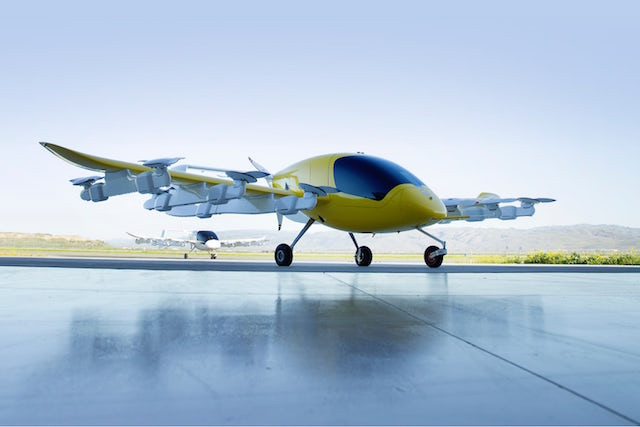Last year, Kitty Hawk and Joby Aviation received a total of nearly $2m from the Defense Innovation Unit Experimental (DIUx), a Pentagon organization founded to help America’s military make faster use of emerging technologies. Neither company, nor the DIUx, disclosed the funding at the time.
The website for Cora, Kitty Hawk’s experimental air taxi, emphasizes its role in solving urban transportation challenges: “Cora is about the time you could save soaring over traffic. The people you could visit. The moments that move you.”
The DIUx’s vision for small electric aircraft is less Back to the Future and more Blade Runner, according to a document that detailed the personal aerial vehicles funding program. It reads: “These vehicles will ... offer a niche capability for specific tactical applications with a low acoustic signature, near instantaneous start/stop, ability to spread an assault force across multiple vehicles, and automated systems.”
Joby Aviation received $970,000 from the DIUx in January last year, with Kitty Hawk receiving $1m a few months later, according to government contracting websites.
Neither company appears to have been running short of money, though. The billionaire Google co-founder Larry Page is bankrolling Kitty Hawk, while Joby closed a fresh $100m investment round in February this year, using traditional venture capital companies.
Although there are many start-ups and established aerospace companies competing to develop electric vertical take-off and landing (e-VTOL) taxis – including Uber, Airbus and Boeing – Kitty Hawk and Joby are among the furthest along.
A portion of Joby’s FAA application.
Experimental airworthiness certificates granted by the Federal Aviation Administration (FAA), previously unreported, detail exactly how and where the aircraft are being tested.
Kitty Hawk received permission for its Cora vehicle, originally called the Mule Self-Piloting Aircraft, to fly over a sparsely populated area around the municipal airport in Hollister, California, about 60 miles south of the company’s Silicon Valley headquarters. Cora combines 12 helicopter-style rotors for vertical takeoff and landing, with wings and a tail rotor for traditional horizontal flight.
Although Kitty Hawk has said Cora would have a top speed of 110mph and a range of 62 miles, its FAA application says that it can actually reach speeds of 150mph, with a battery life of 19 minutes. That would correspond to less than 50 miles in range, although the aircraft does have 10 minutes (up to 25 miles) of reserve power. The two-seater aircraft can carry just 400lb in passengers and cargo, and flies at up to 10,000ft.
For its initial tests, however, Cora would fly at below 200ft, and only over Hollister airport, approximately three times per week. Later tests would include vertical takeoff and landing, hovering, and transitioning to normal flight at up to 5,000ft. Its FAA certificate permits Cora to fly itself, with a pilot overseeing it from a control station on the ground. It can even fly with humans on board, although not paying passengers. Kitty Hawk must also provide a chase car or plane to shadow Cora.
The original aircraft certified by the FAA is now undergoing flight testing in New Zealand, where Kitty Hawk has said it will also launch its commercial air taxi service. However, Kitty Hawk remains very active in the US. In June, it unveiled a one-person flying boat called the Flyer. It has also set up a previously unreported subsidiary called Ground Ops LLC that explored participating in a federal unmanned aircraft system integration pilot program to test drones and autonomous aircraft in commercial airspace. Kitty Hawk told the Guardian that it was not commenting on funding and testing at present.
Images from Kitty Hawk’s FAA application.
Joby Aviation’s S4 aircraft is even more ambitious than Cora, carrying four passengers and with an intended range of 150 miles on a single charge. The S4 has a wingspan of 35ft, to Cora’s 36, and is 24ft long. In the FAA application, Joby did not specify the S4’s top speed from six innovative tilting rotors. However, the company did note that its current chase helicopter, which has a top speed of 140mph, may not be fast enough for future flight testing.
Although neither vehicle can automatically sense and avoid birds or other aircraft, both are programmed to return safely back to base if their remote control systems fail. Joby’s S4 also has a full-aircraft parachute in case it suffers “a catastrophic failure”.
The S4 will mostly fly over agricultural areas and the open ocean from the ranch of Joby’s CEO, JoeBen Bevirt, located in the hills above Santa Cruz. It will also operate out of Fort Hunter Liggett, a large US army base 150 miles south of San Francisco. The FAA application says Joby has a “Department of Defense contract to perform test operations” inside the base’s airspace. Joby did not respond to multiple requests for clarification.
In May, Uber announced that was co-developing an ultra-quiet rotor for a flying taxi with the US army.
Lt Col Michelle Baldanza, a defense department spokesperson, would say only: “DIUx is working with various personal aerial vehicle companies, all of which are selected via a competitive process open to any commercial entity.”
The Pentagon will not be taking possession of a military air taxi any time soon. The FAA airworthiness certificates for both vehicles specify: “No weapons may be added to the [unmanned aircraft].”
Mark Harris in Seattle


